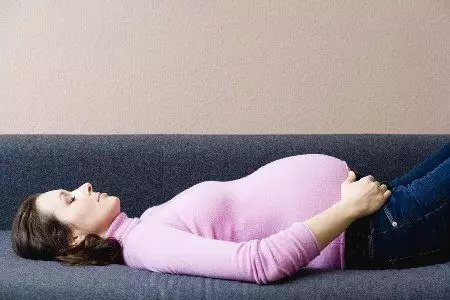This article presents the advantages of the active participation of the parturient in childbirth and the use of vertical positions during childbirth.
Few women realise how crucial her stable emotional state is to the proper course of labour. The stress that most often accompanies a woman presenting for labour causes an increase in adrenaline levels, which blocks the production of natural oxytocin. This results in a weakening or sometimes even inhibition of the labour action, significantly slowing down the birth. The ability to move freely in the birthing room, to adopt comfortable positions, to use objects that facilitate relaxation during the first period of labour (e.g. a Sako bag, birthing ball), the presence of your partner or another person close to you and the friendliness of the staff are all factors that can greatly reduce the feeling of anxiety that is a stress factor. It is also worth remembering that the right atmosphere in the birth environment has a very positive effect on the course of the birth. Excluding aggressive stimuli such as harsh light or irritating sounds from the environment allows for better concentration and increases the amount of oxytocin secretion. A positive attitude and reduced stress by being able to actively participate in the birth is one of the most important advantages of active birth.
It has been calculated that giving birth is a huge effort comparable to walking about 40 kilometres at a brisk pace. It goes without saying, therefore, that skilful regeneration and the saving of strength are essential elements in order to walk this distance without problems. Properly conducted relaxation training during the intervals between contractions makes it possible to increase the efficiency of the use of strength during childbirth. Positions with a sako bag or a companion allow for complete relaxation and the storage of strength for the contractions and expulsion. A comfortable position, relaxed and regular breathing, the relaxation of all muscles, as well as closing the eyes or gently massaging the partner are all elements that help the parturient to calm down and achieve complete relaxation. It is worth ensuring that relaxation techniques are well practised before the birth. Then each woman can choose the relaxation elements that have the most positive effect on her.
The vertical positions have a strong influence on the regularity as well as the intensity of the uterine contractions. As a result, it is less often necessary to administer substances that induce or intensify the labour. Stronger and more frequent contractions are more effective, thus shortening the duration of labour. The movement and instinctive choice of position makes the contractions less painful for the mother.
During a physiological birth, when the head passes through the birth canal, the coccyx bends slightly backwards, increasing the size of the bony pelvis. When lying flat on her back, the bony prominence is limited and the passage of the head is impeded. The parturient may then feel pain in the sacral area. In upright positions, the bony prominence of the cervical bone can be flexed, thus reducing pain.
In upright positions, the foetus's head faces downwards and the natural force of gravity favours its correct insertion into the birth canal and also facilitates the expulsion of the foetus. There is also a quicker and gentler dilation of the cervix through the greater force of the head against the cervix, while reducing the risk of injury to the cervix.

Because the muscles in the pelvic floor and perineal tissues are under much less tension during an active birth using the vertical position than in the traditional "supine" position, the expulsion of the foetus is smoother and perineal trauma or incisions are less frequent. This allows the obstetrician to return to full mobility more quickly.
Positions other than the "supine" position, in which the mother is usually laid on the birthing bed, promote better blood supply to the placenta and a better oxygen supply to the baby. Prolonged lying on the back puts the pregnant uterus under pressure on the descending aorta and the internal vena cava. This results in impaired oxygen supply to the foetus, more frequent foetal cardiac arrhythmias and an increased feeling of fatigue and exhaustion in the parturient. In extreme cases, so-called inferior vena cava syndrome may occur, characterised by progressive symptoms of shock, which can be a dangerous complication of the course of labour. In addition, these positions allow easier breathing and adaptation of breathing with the specific rhythm of the uterine contractions. When lying flat, breathing becomes shallow and ineffective.
The large amount of movement during the first phase of labour and the adoption of a squatting, sitting or kneeling position during the expulsion of the foetus make labour easier and enable the baby to pass gently through the birth canal. All the advantages of the use of vertical positions during active birth combine to make childbirth an act that can be a most beautiful experience for the woman and her partner, without necessarily being associated with involuntary compliance with hospital rules and prolonged pain and exhaustion. It cannot be denied that the number of positives resulting from the use of these positions is an element influencing the increasing leaning towards nature and the increase in active births taking place in delivery rooms. Vertical positions are fully inclined to achieve a reduction in the duration of labour, a significant reduction in labour pains and a reduction in trauma to the birth canal and the head of the fetus, while the active participation of the parturient in the act of delivery is associated with a reduced risk of birth complications.









